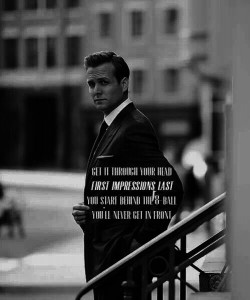 Impressions count. A lot. You communicate so much through your choice of how you present publically, yet do you take it as seriously as you should? Consistently?
Impressions count. A lot. You communicate so much through your choice of how you present publically, yet do you take it as seriously as you should? Consistently?
Here’s the thing about impressions and communication: we all see exactly what we want to see. When our mind is already decided – and our mind decides in the blink of an eye – then we just look to confirm what we already believe. We love to be right and hate to think that we made a wrong call. So those impressions, especially that first one, really counts. Because it lasts, and first impressions are nearly impossible to change. We are so reluctant to give up that warm fuzzy feeling of being right.
Couple the confirmation bias with another human trait: we are wired to focus on the negative, and now you see the problem. Much as we claim that we are objective (“Who me? I can keep an open mind”) about things all the time, we can’t help but be judgmental. We have an opinion on everything, in the name of honesty, and it’s typically not positive: “Here’s what I think…”, “Why would you do that?”, “Not a good idea, IMHO”, “He’s such a (fill in the blank)”, etc.
We see a man with wild hair and a long scraggly beard, so what do we immediately think? ‘Mountain man’, potentially mentally deranged, with increasing feelings of discomfort and lack of safety, as the space between you and wild man closes in. Not very positive. Why the unwarranted judgments, based merely on an impression without any prior negative experience with the man? Impressions, the emotions we form when we see something, trump logic.
After quickly sizing up the situation, our thoughts immediately turn negative as a means of self-protection. If this approaching wild looking man is dangerous, we need to be ready to defend, fight, or flee. He is potentially a threat and we need to keep our guard up. Way up. So we stay vigilantly negative and wary.
If the impression was different, if the unfamiliar male was clean shaven, neatly groomed and well dressed, well now things are very different. The impression would not be of a potential threat but of a potential opportunity, and we would smile, relax and feel safe. This bias, called the halo effect, benefits the attractive, allowing good looking criminals to easily fool people because they ‘didn’t look like a criminal’.
When you are presenting publically you have the opportunity to give yourself an advantage every day, with every interaction. But do you take the opportunity seriously or do you squander the opportunity carelessly? “I’m comfortable in my sweats and old jeans” may be true, but more true is that credibility and trustworthiness is wrapped up in the business ‘uniform’.
Darn, am I ‘on’ all the time, can never relax, and have to keep up appearances around the clock? Hopefully, the real you is genuine and you’re not putting on a show of charm, but, yes, whenever you are out in public, your personal brand is open for others to form impressions around the clock. Brand consistency, since you never know who you’re going to meet or when/where.
You can’t turn others’ impression off, and there is no such thing as a 2nd 1st impression. When I was working in financial services, several of the young interns thought it was OK to party hard at night at the local bars. Big mistake. The advice then was: ‘don’t behave in any way that a picture of you published on the front page of the paper would need an apology’. With social media and cell phone cameras in every hand, this is even more important advice to adhere to today.
(The corollary to that was: don’t say anything that you wouldn’t want to see published in the headlines – updated today to: that you wouldn’t want to see tweeted — but that’s a whole other post.)
